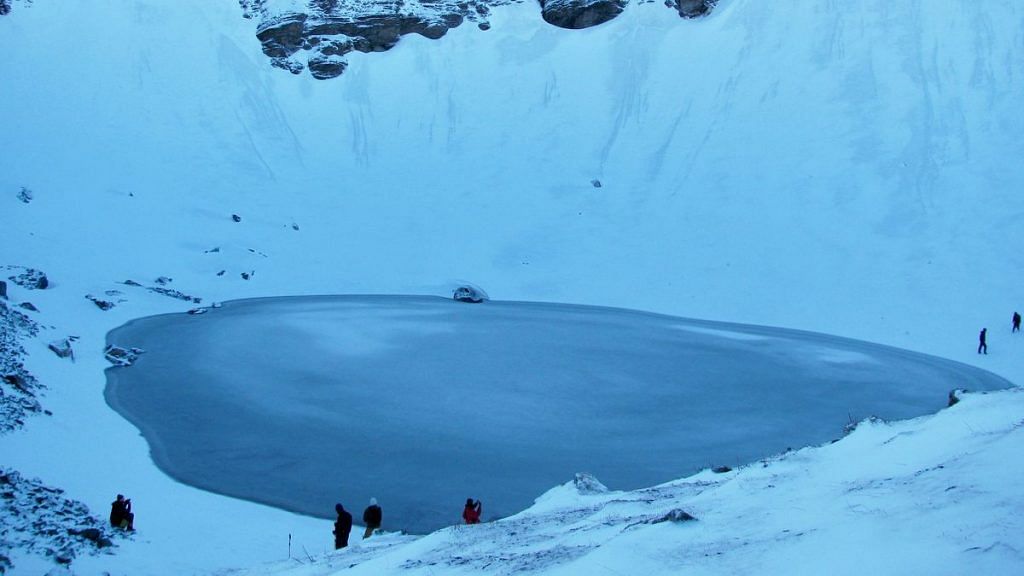New Delhi: The popular Nanda Devi Raj Jaat Yatra of Uttarakhand may have drawn pilgrims since as far back as the 7th century. The pilgrimage may even have attracted tourists from eastern Mediterranean regions such as Greece and Crete in the 17th century.
These and many other revelations were made in the first whole genome DNA analysis of skeletal remains found in and around the shores of Roopkund lake on the yatra route.
Roopkund is a glacial lake situated at over 5,000 metres above the sea level in Chamoli district of Uttarakhand. The large number of skeletal remains around it have for long puzzled scientists.
“Roopkund Lake has been a subject of speculation about who these individuals were, what brought them there and how they died,” said Niraj Rai, who began working on the research as a post-doctoral scientist at the CSIR Centre for Cellular and Molecular Biology (CCMB) in Hyderabad.
Until now, it was thought that a major catastrophic event such as a lightning might have killed a large group of people at the same time.
Skeletal remains of 38 individuals under study
The new DNA study conducted by an international team of scientists shows that these skeletons belong to distinct groups that died at multiple periods in at least two episodes separated by 1,000 years.
The team conducted a whole-genome sequencing of 38 individuals.
Published in the journal Nature Communications, the study shows there are three distinct groups among the Roopkund skeletons.
At least 23 individuals had ancestry related to people from present-day India. However, these people did not come from the same geographical location. They came from different parts of India and from various timelines.
Rai, who now works at the Birbal Sahni Institute of Palaeosciences in Lucknow, believes these individuals were on a pilgrimage between the 7th and 10th centuries CE.
Also read: Uttarakhand could see catastrophic floods if global warming targets are not met
Foreign tourists may have died from hypoxia
The Nanda Devi Raj Jaat Yatra is one of the toughest pilgrimages that passes through the Roopkund area. This is possibly the first scientific study to show that the pilgrimage was popular from before the 7th century, Rai said.
The research also found 14 individuals having ancestry most closely related to people who live in the eastern Mediterranean, especially present-day Crete and Greece. A third individual has ancestry that is more typical of that found in Southeast Asia.
Radiocarbon dating showed that these groups arrived at Roopkund Lake between the 17th and 20th centuries.
“The most logical explanation is that a group of Greeks accompanied Indian pilgrims to the site. They may have undertaken the trip as an adventure. By the 17th century, the trek was probably easier as porters were available to assist people. Eventually, these tourists may have been separated from the Indian group and gotten lost,” Rai told ThePrint.
Rai speculates that the group of foreign tourists may have died from hypoxia.
“The presence of individuals with ancestries typically associated with the eastern Mediterranean region suggests that Roopkund Lake was not just a site of local interest but drew visitors from across the globe,” said Eadaoin Harney of Harvard University.
Rai also informed that the team will now try to ascertain the cause of death of the various groups.
“Many skulls have spoon-shaped trauma. We are going to analyse those individuals who have suffered trauma,” he said, adding that these may have been caused by hailstorms.
“We will try to find out if all the groups died due to hailstorm or some other reason. We will also look into the pathogen profiles to see if they were infected with diseases such as leprosy or tuberculosis,” Rai added.
Also read: In 31 months, Modi govt has completed just 1.1 km of work on Char Dham highway project
